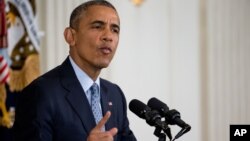Analysts have mixed assessments of President Barack Obama's announcement Thursday that American troops will remain in Afghanistan at the current level of 9,800 throughout 2016 and then be reduced to around 5,500 troops in 2017.
Some analysts suggest that the U.S. decision to maintain current troop levels in Afghanistan is basically kicking the can down the road.
Michael Kugelman, an expert on South Asia at the Washington-based Woodrow Wilson Center, believes that Afghanistan will be handed over to the next U.S. president whoever that may be.
“It is the case of kicking the can down the road because whoever the next U.S president is will have to make big decisions about the U.S. troop commitment. He or she will need to decide whether to scale it down and bring troops home or to ramp it up and send even more,” said Kugelman.
But Jason Campbell of the Rand Corporation disagrees with that assessment and calls Obama’s decision sound and in line with the conditions on the ground in Afghanistan.
“I do not think it’s kicking the can down the road at all,” said Campbell. “I think leaving the troops level through 2016 is certainly an appropriate decision, because they are providing a lot of very valuable training, mentoring and providing guidance to the ANSF, and I think the alternative is to cut the troops in half by the end of this year, which would be too drastic given what’s happening in Afghanistan right now.”
The impact of ISIS
The United States along with a coalition of allies is carrying out regular airstrikes against Islamic State targets in Iraq and Syria. Some analysts in Washington believe that the vacuum created by the U.S withdrawal from Iraq partly contributed to the rise of ISIS in the region. ISIS, also known as ISIL, is believed to have made inroads in Afghanistan as well which led to concerns that if left alone, Afghanistan might face the same fate as Iraq.
Michael O’Hanlon of the Washington-based Brookings Institution believes that the U.S. decision to remain in Afghanistan was influenced by a number of factors including the infiltration by ISIS.
“I think it’s a combination of the rise of the ISIL, the strength of the Taliban, the ongoing role of Pakistan which is sort of a mixed role complicating the situation, and the fact that much of Iraq and Syria fell to ISIL,” said O’Hanlon.
O’Hanlon added that Afghanistan presented strategic and political risks, and that Obama did not want the same thing to happen in two different places, drawing a comparison to the situation in Iraq and Syria.
Are Afghans up to the task?
Afghan national security forces have been fighting the Taliban on their own almost since late 2014 and they have shown impressive progress in the fight so far taking a lot of causalities.
Jason Campbell of the Rand Corporation believes that Afghan national security forces still need assistance.
“It certainly demonstrates that the ANSF are not as far along as was previously hoped for this period,” said Campbell.
Michael O’Hanlon agrees and adds that Afghans still need more help and more time.
Afghans on the other hand demand military equipment to fight the insurgents, including a functioning air force that could perform close air support missions.
But Kugelman says that while military equipment is important, the Afghan military needs to know how to use them as well.
“I know there are Afghan military officials that think the focus should be on equipment and arms, not simple training and advice. That’s certainly something to be said for that,” said Kugelman. “But the problem is that Afghan forces need to be trained to use this equipment.”
The regional impact
Countries in the region all seem to be in favor of continuing the U.S. presence in Afghanistan because failure in that nation will have an impact on them in the form of refugees and militants.
Jason Campbell of the Rand Corporation believes that a secure Afghanistan is in the interest of all regional countries in whether they are friendly to the U.S or not.
“I think in a nutshell all of those countries have a very distinct interest in Afghanistan remaining somewhat stable and certainly don’t benefit from a reprisal of what happened in the 1990s civil war,” Campbell said.
During that conflict, millions of Afghans had to seek refuge in neighboring countries, particularly Pakistan and Iran.








